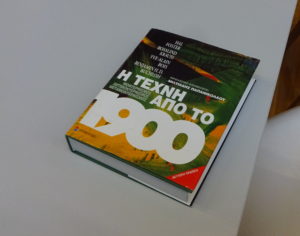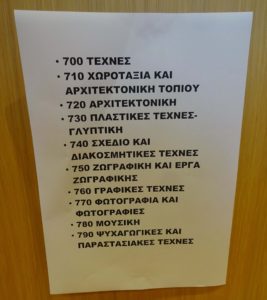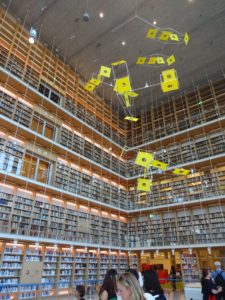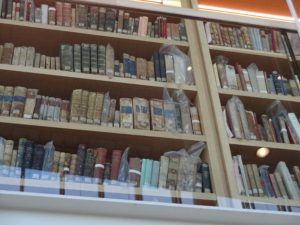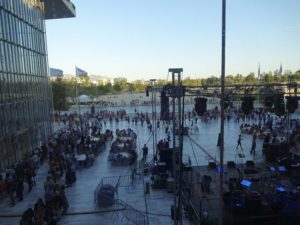IFLA WLIC 2019
Athens, Greece
24-31 August
Attendance at an IFLA WLIC is a profession-affirming experience. As a solo librarian, it can be easy to become isolated and the activity of WLIC, the sessions attended, the posters viewed and the exhibition navigated remind one of the bigger picture. The discussions that ensue and ideas that foment help sustain a solo librarian in those dark times when they are wrestling with the implementation of a new library system or are struggling to sift through the piles of donations for treasures to enrich their collection or are trying to compile an issue of a journal.

For me the conference began a few days early, when I attended the first day of the joint Committee on Cataloguing and Committee on Standards satellite meeting (21 August). They organized this along with the European RDA Interest Group EURIG and it was held at the Aristotle University in Thessaloniki. There were useful background sessions about the implementation of RDA, its internationalization, and its features. I found much of this information too technical for me, an end-user who does not catalogue every day and does not have a lot of time to contemplate the minutiae of RDAs enhanced capabilities. I appreciate the flexible capabilities of RDA, but in my overwhelmingly print-based formats and relatively small, under-staffed library, RDA can feel, at times, like overkill. Of course it may not always be that way and I appreciate the need to move on from AACRII and the MARC format.
Renate Behrens discussion of Application Profiles piqued my interest. This is something in development in the German-speaking library environment in which I work and will act a bit like templates to ensure consistent data elements are included in catalogue records. I look forward to following the development of APs.
My main interest in attending this satellite meeting was its focus on RDA in non-English environments. Germany adopted RDA at the end of 2015/early 2016 and implemented it throughout the various co-operative catalogues in the country. I have learned RDA not in my native language, but am fortunate that I can refer to relevant sections in English, when I am confused. RDA implementation also saved me from having to learn Regeln für die alphabetische Katalogisierung (RAK), the previous cataloguing rules used in Germany, and for that I am eternally grateful. However, I was interested also to hear how RDA is done in other countries.
Christian Aliverti presented an informative discussion about the difficulties of using RDA in the National Library of Switzerland, across 3 (and in some cases 4) official languages. Maria Aslanidi presented what can only be described as her heroic efforts in translating RDA Reference into Greek (see Fig. 2).

She made helpful suggestions and observations based on her experience, which should become guidance and consideration for anyone in another country embarking on a similar translation into their language. It was also interesting to hear about the progress of implementation both in Italy from Mauro Guerrini and in Sweden from Katarina Synnermark. All of these papers gave me a greater understanding of how widespread (or not) the take up of RDA is.
The organizing committee, speakers and Dr. Aikaterini Nasta and her staff at the AUT Library extended a hospitable welcome and provided an engaging and enjoyable programme. I was able to use a bit of my long dormant Greek and received many tips on further library visits and travel for northern Greece. I spent a few days with friends in Kozani, a regional city in which I once lived. They have recently opened the impressive Koventareios Municipal Library (see Fig. 3), which also houses local archives. Eleni Margariti, one of the librarians, gave my friends and I an impromptu tour one evening, which included a familiar title (see Fig. 4) and the art classification (see Fig. 5).
I remember the old library in Kozani, into which I was welcomed 25 years ago and shown some of the treasures, then stored in a cupboard in the Librarian’s office because it was the most secure place. It has taken awhile to get the new building, but those treasures can now be used in a special collections reading room and preserved in secure, climate-controlled storage.

Athens
I was registered for 2 days of the WLIC, which allowed attendance at one of the Art Libraries Section standing committee meetings. There were many faces new to me and wider representation from Australasia and Asia. I learned the programme at next year’s WLIC in Dublin will have the theme of decolonization, which is also the theme of issue 4 of the ALJ in 2020, which is being co-edited by Daniel Payne of OCAD University in Toronto and I. There will also be a satellite session on the theme of the future of art libraries. There were updates from members of the standing committee about their own institutions and activities. A head’s up is the Art Libraries conference (a biannual conference organized by members of the Art Libraries Group Catalogue) will likely be held in London in autumn 2020.
Some of the sessions attended:
Open Access Principles for Cultural Heritage
Stacy Allison-Cassin moderated a packed session about Open GLAM principles. She was arguing for a more nuanced view of open access principles (openglam.org/principles) based on accumulated knowleedge of digital projects over the past 10 to 20 years. Some of the issues, particularly ethical ones, were not envisioned when many heritage institutions digitized, and released to the world, parts of their collections. Concerns have been raised by many communities about the public exposition of artefacts that have sacred or personal significance. Indigenous data sovereignty needs to be respected and they need to have control over how access rights are implemented. One solution that has been used in some collection databases is traditional knowledge labels to monitor and control access rights. The Open Glam movement needs to acknowledge in its principles that adequate time should be allotted to working with Indigenous communities, so their views are both represented and respected if their artefacts are to be digitized.
There are also calls for the principles to reflect that digitization is not a cheap undertaking and that labour needs to be rewarded. The benefit to society and educational value of open access also needs to be emphasized in archive donation agreements and the principles could include testimonies of donors in support of this aspect of the work.
Allison-Cassin was keen to stress this dialogue is ongoing and encouraged participation through the OpenGLAM mailing list.
The Migration of Books: Cultural Heritage (objects) and Ideas on the Move (Rare Books & Special Collections Session)
There were 4 diverse presentations about issues around the movement of cultural heritage – legitimate dispersal and historic (and contemporaneous) looting and trafficking of antiquities and books. Isabelle Nyffenegger discussed the Bibliotheque Nationale de France’s project aimed at digital reunification of dispersed collections, while Godwin Arua presented how Nigerian culture, both tangible and intangible, has been transmitted through objects. So many of these objects are now found in collections around the world, either through of colonial looting and present day trafficking. Fabrizio Govi’s paper was about Italy’s legislation governing the antiquarian book trade. In the final paper, Arda Scholte of the Export Group Against Theft, Trafficking and Tampering of the International Council on Archives explained the framework of co-operation that has developed out of the group’s action plan. They are also working on ways to define and report on stolen and trafficked objects; developing prevention training programmes in libraries and archives; and raising awareness of the issue amongst the general public.
The cultural evening was held at the Stavros Niarchos Foundation Cultural Centre. Here we were able to visit the new National Library of Greece, enjoy a delicious dinner, Greek music and dancing and a view of Athens as the sun went down.
I always enjoy seeing the poster sessions because the sheer breadth of ideas, although a recurring theme from many posters was diversity, inclusion, and services to support those aims.

Libraries, Archives and Museums in Dialogue (Art Libraries Section with Subject Analysis and Access)
Claire Eggleston spoke about the Art Gallery of New South Wales (AGNSW) project to enable searching across their library, archive and photograph collections. She highlighted how, through selective cataloguing (and digitization) of library and archive material into the gallery’s collection management system (Vernon), they have made almost 10,000 items more visible for people searching on the museum system. They developed a hierarchichal system within Vernon to demonstrate the relationships between items and, at the same time, developed an in-house cataloguing standard for this type of material, which is not necessarily accommodated well in an object system. She also mentioned some challenges, including the overload of the web infrastructure with high volume of library and archive materials.
This combined ALS and Subject Analysis and Access Committee session was about improved search retrievability across databases. All the presentations were interesting, but some were very technical and outside of my scope. However I did also enjoy the paper given by Alia Levar Wegner and Stefanie Hilles of Miami University in the US. The approach was re-visit a collection of trade cards that had been digitized almost 20 years ago and to retrospectively improve the metadata, providing context and, in some cases, missing basic information, thereby making the collection more discoverable and more useful to art researchers. It was an insight to how poorer quality and rushed digitization projects can enjoy a second (or third) life through improving existing files and images.
How library publishing can act as a dialogue for change – Library Publishing SIG
I was curious about this session – as an editor – but also a bit uncertain how library publishing was defined. The talks were interesting and the format was more of a lightning talk. They addressed the idea of libraries creating and publishing their own publications as a means of circumventing mainstream publishing. Reggie Raju’s talk about establishing an Africa-wide platform for library publishing was a conference highlight. The librarian from the University of Cape Town did not mince his words and his directness about how mainstream journals exclude African authors was refreshing.

Bookbinding through the ages – Stefanos Kolovouris
This was a final indulgence. It was, however, more a superficial overview of binding history, with images of his own bindings. They were beautiful and definitely luxury end of the market, but I had been hoping for a more academic study with a conservation approach.
Many of the papers from the congress are available via the IFLA website http://library.ifla.org/view/conferences/2019/. And I encourage everyone, if they can, to attend next year’s congress in Dublin. The call has recently gone out for volunteers and registration is now open https://2020.ifla.org/
I’d like to thank ARLIS for their financial assistance in attending the conference. It is so important for ARLIS/UK & Ireland and for the Art Libraries Journal to have a presence at international conferences. We benefit personally and as a profession from the ideas and contacts we bring back from around the world.
Erica Foden-Lenahan
Editor, Art Libraries Journal
Librarian, Staatliche Akademie der Bildenden Künste Karlsruhe
Images
All photos by Erica Foden-Lenahan


